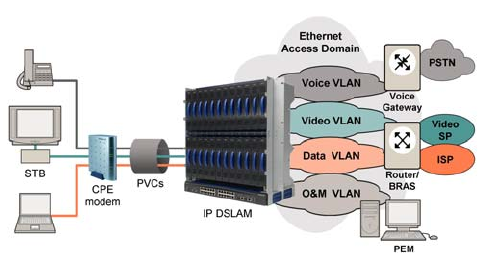
13
The following VLANs are depicted in the figure below,
as an example of using VLANs per service:
• Voice VLAN for voice ToIP service
• Video VLAN for video broadcast
• Data VLAN for Internet access service
• Management VLAN used for all O&M
Access methods
Access methods are used to define rules suitable for
specific end-user host configurations and behavior.
An access method provides the basic filter functions to
enforce policies related to establishing and maintaining
end-user sessions on a PVC or a VLAN. It is
consequently a basic part of defining a traffic mapping
definition. Traffic mapping definitions can be
established using one of the following access methods:
• DHCP
• PPPoE
• Static IP address
• Transparent LAN/VLAN
• IPoA and PPPoA (EDN312)
Transparent LAN/VLAN services
Transparent LAN services provide VLAN transparency
between home offices or connection of multiple offices.
EDA provides the VLAN transparency by encapsulating
en-user traffic using stacked VLAN. Up to five VLAN
tags are supported, including up to two tags added by
the IP DSLAM.
Business access
For business access, EDA offers ADSL, ADSL2, and
ADSL2+ Annex M, a symmetrical service that enables
the business solution to offer high capacity uplink and
downlink traffic suited for business applications.
Provisioning
Combined with PEM, EDA 1200 provides a number of
profiles and templates to create services in an easy
way. By pre-defining service and line configuration
profiles, end-user provisioning is easily created by
choosing the desired template.
Profiles can also be incorporated within the Access
Node. This feature can be used to automatically provide
the configuration defined in a profile to all end-user lines
(bulk pre-configuration) or to a group of lines.
In combination with PEM, EDA 1200 can make bulk
configuration by use of XML files with the desired
configurations. A GUI is provided to manage the
execution of the XML file and the result will be
presented in a log file.
Operational mode
EDA is highly versatile and can be deployed in any
network configuration. The EDA system offers Ethernet
connectivity to the end-user for any kind of service.
Basically, the EDA system acts as an extension cord
from the backbone network to the end-user, using DSL
as drop technology.
The IP DSLAM creates an end-to-end virtual LAN
architecture between the Ethernet access network and
the CPE Ethernet, encapsulating the Ethernet frame
over the ADSL connection between the IP DSLAM and
the CPE. This architecture is also known as Bridged
Ethernet. This applies to voice, video, and data services.
EDA supports DHCP Option 82 according to RFC 3046
on a PVC basis. For authentication by the service
provider, a configurable identifier is attached to the
DHCP request from the end-user.


















